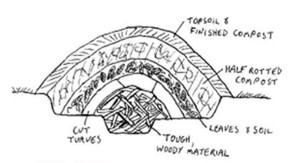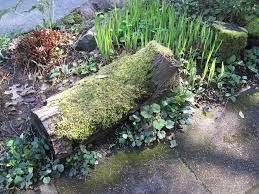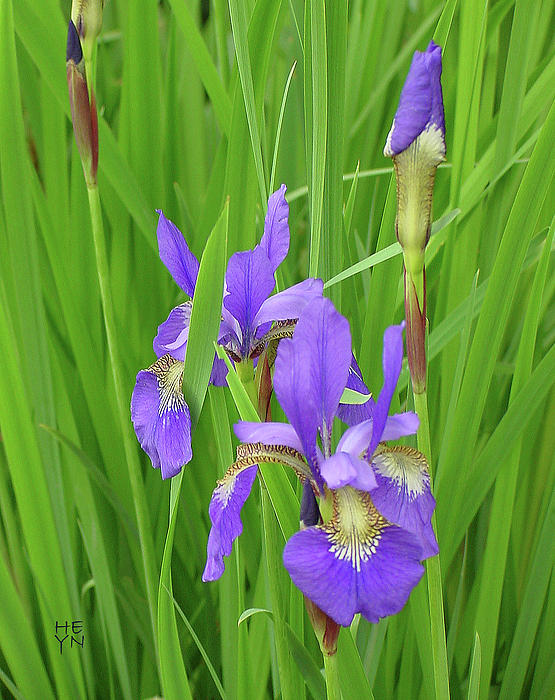If you have the good fortune to live close to a marsh you will be able to observe the comings and goings of the most biodiverse ecosystem on the planet. Wetlands are comparable to rainforests and coral reefs for the sheer number of plant and animal species that they support. Some people see swampy land as a breeding ground for mosquitoes with no inherent value. They itch to drain the land, fill the low spots and use it for agriculture, housing or industry. Around the world such practises have changed the climate, released tons of carbon into the air, extinguished untold animal species, created droughts, fouled the water, eroded shorelines and caused destructive and widespread flooding.
There are no bylaws to prevent the filling in of upper wetlands and even those along shorelines in Haliburton County have been allowed to be destroyed. Fortunately, a new Shoreline Preservation By- law will protect some of these shoreline wetlands and upland ponds but still much will remain under protected. Click here to read more about how local laws do and don’t protect forests and wetlands. The township of Minden has had the foresight to demarcate the wetland in the middle of their town as a park and put in a Boardwalk that is popular with walkers and photographers. And it’s a good thing because the damage to roads and properties due to three ‘state of emergency’ flood events in a recent six year period would have been a whole lot worse without the wetland.
The Minden marsh absorbs a great quantity of water during a torrential rainstorm. The water spreads out along low lying areas and the marshes slow and filter the water preventing the banks from overflowing and flooding. These and other marshes help to balance the level of water throughout the year within the Gull River watershed. The Minden Wetland also filters out pollutants and excess nutrients reducing the algae growth in Gull Lake and others downstream. Too much algae growth robs the lake of oxygen which can result in the death of fish and is a sign of a system badly out of balance. No one wants to live on a dead lake.
Value forests and vegetated shorelands
The forested hillsides and shorelands in our region also play a critical role in our health, safety and well-being. Forests filter and regulate the flow of water. Their leaves capture and slow the fall of rain to the forest floor, which acts like an enormous sponge, absorbing up to 46 centimetres (15 in) of precipitation before gradually releasing it to streams and recharging ground water. On average an untouched forest floor can absorb 2/3rds more rain than a cover of suburban turf.
If you have a low marshy area on your property, you could make it an attractive feature instead of filling it in. If it’s in a sunny area, you might want to plant blue eyed grass (Sisyrinchium) or the native bright red Cardinal Flower (Lobelia cardinalis) If it receives shade how about planting a fernery. There are a number of native ferns and other moisture loving plants for sun, shade and the in between. For more plant descriptions please consult the Directory of Native Plants for Your Property including Shorelines as well as considering the list of plants below.
To choose the right plant for the right place we need to understand the shoreline zone and the littoral zone. The shoreline is where water meets the land and this line can fluctuate seasonally and as a result of the Trent Severn management of the dams in the over 600 lakes of Haliburton County. The plants in this zone we’ll call shoreline plants. The littoral zone is the near shore area where sunlight penetrates all the way to the bottom and allows aquatic plants to grow. In this zone we include three types of plants. Emergent plants, Floating plants and submerged plants
Diagram of the four types of aquatic plants:

1.Shoreline or Marginal Plants are found where water meets land. They like moist soil and seasonal flooding. (Blue flag iris, some shrubs and trees)
2. Standing Water or Emergent Plants have their roots in the soil under water but grow up and emerge out of the water.
3. Floating Plants float at or near the water surface and have either floating roots or roots in the soil at the bottom (eg. duckweed and lily pads)
4. Submerged Plants are completely underwater and have roots in the soil at the bottom. (e.g. pond weed and bladderwort)
Shoreline Plants are an important food source for pollinators like bees, birds, butterflies and moths. Since these plants grow tall, mammals and invertebrates like frogs use them to hide from predators. You will find descriptions of many plants suitable for shorelands such as the Blue Flag Iris, Meadowsweet, Boneset, Joe Pye Weed, Turtlehead, Swamp Milkweed, sedges, and ferns in the Directory of Native Plants. You will also want to peruse the article on Solutions for Erosion for a good selection of plants that can adapt to both wet and dry conditions.
If you’re looking for a taller ornamental shrub for the shoreline you can’t go wrong with our two native hollies.
 Mountain holly (Nemopatthus mucronate) can often be found growing in full sun in wet areas. It can be naturalized in wet woodland landscapes, where it will form dense colonies. It will grow to 2 metres tall and 1 metre wide. The attractive red berries are an important food source for migrating birds and disappear quickly in autumn. Male and female plants are required for fruiting. Full sun required for good fruit production. Propagate by softwood cuttings.
Mountain holly (Nemopatthus mucronate) can often be found growing in full sun in wet areas. It can be naturalized in wet woodland landscapes, where it will form dense colonies. It will grow to 2 metres tall and 1 metre wide. The attractive red berries are an important food source for migrating birds and disappear quickly in autumn. Male and female plants are required for fruiting. Full sun required for good fruit production. Propagate by softwood cuttings.
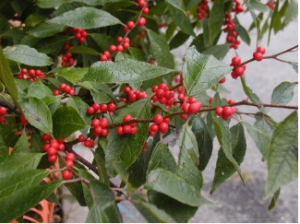 Winterberry (Ibex verticillata) is a holly shrub 1-5 m tall so called because it retains its berries into winter unlike its close cousin the Mountain Holly. In wet sites, it will form a dense thicket, while in dry soil it will grow slowly into a smaller shrub. It has lovely glossy leaves, tiny flowers but beautiful red fruits that provide winter food for the American Robin and other birds. Male and female plants are required for fruiting. Full sun required for good fruit production. Propagate by softwood cuttings. Photo credit: SB_Johnny
Winterberry (Ibex verticillata) is a holly shrub 1-5 m tall so called because it retains its berries into winter unlike its close cousin the Mountain Holly. In wet sites, it will form a dense thicket, while in dry soil it will grow slowly into a smaller shrub. It has lovely glossy leaves, tiny flowers but beautiful red fruits that provide winter food for the American Robin and other birds. Male and female plants are required for fruiting. Full sun required for good fruit production. Propagate by softwood cuttings. Photo credit: SB_Johnny
Emergent Plants are important in providing a buffer from wind and wave action that can wash out shorelines. Waterfowl such as mallards and wood ducks feast on emergent plants. They also use their sturdy stems and leaves to build nests. Fish and insects also use these plants for cover and food.
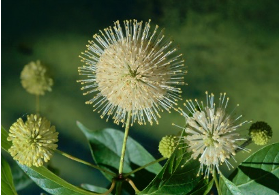
Plants like Common Buttonbush (Cephalanthus occidentalis) is a real showstopper with its fuzzy, golf ball shaped flowers which appear in August. It’s a fulsome spreading shrub or small tree that needs wet to moist conditions like those found in ponds and marsh areas. It thrives in sun to part sun. Ducks and other water birds and shorebirds consume the seeds and songbirds love the fruit. Butterflies, bees, and insects are attracted to the fragrant, nectar rich flowers. It also provides nesting habitat for songbirds and if we haven’t sold you on this plant yet it is deer resistant.
Tawny Bog Cotton (Eriophorum virginicum) is common in sphagnum bogs and wet ditches. This unique sedge is one of many cotton grass cultivars with a flower that has a white to tan bristly appearing but soft, cotton like mass 1 to 2 inches across. It blooms from June to September. The leaves are flat and grass like.
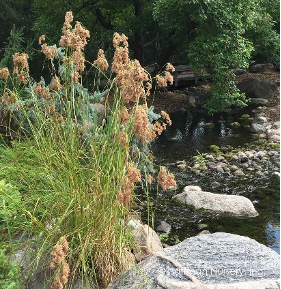
Wild Calla (Calla palustris) forms dense colonies and spreads by rhizomes. Blooming in late spring It has a lovely white flower followed by bright red berries. It can tolerate partial shade and grows from 20-30 cm tall.
Scirpus cyperinus and Scirpus validus are the most common species among the bulrushes. They grow in wet soil, full sun, or light shade. It’s good for erosion control when planted en masse. Bulrush forms a buffer against wind and wave action and protects other less robust aquatic plants to grow. It has a lovely woolly head and not to be confused with cattails.
Sweet Flag (Acorus americanus) grows to 30 cm tall in full sun. It can form stands of sword-shaped, stemless leaves similar to Iris leaves but with an understated furry flower that emerges from a stiff spath. The “sweet” in the name comes from the scent the leaves give off when broken. Rhizomes allow a plant to die back and survive the winter.
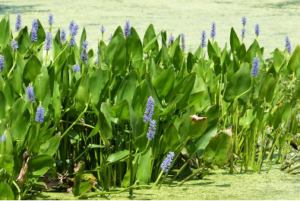
Pickerelweed (Pontederia cordata) has heart shaped leaves and showy deep blue spikes of flowers grows to 30 cm tall.
Arrowhead (Sagittaria latifolia) The leaf is arrowhead shaped and in mid summer a lovely white flower emerges. It grows in calm waters and its rhizome was eaten by local tribes.
Cattails (Typha latifolia) are widely recognized as a 2-meter-tall water loving plant that bears a brown fruiting head that looks like a hotdog on the top of its study stalk. It’s sword shaped leaves rustle in the breeze and turn yellow brown in autumn. Their root systems help prevent erosion. They provide protection and nesting habitat for many birds, reptiles, insects and animals. Their “nutlet” seed fruits are an important food for many species of insects and that then become food for other species. They also provided important food source for local tribes.
Floating Plants help keep algae in balance by absorbing nutrients, blocking light and cooling the water. These same factors provide an underwater habitat perfect for fish hunting for water insects. They provide landing places for mosquito loving dragonflies and other insects and invertebrates.
Yellow Pond Lily (Nuphar variegate) will do well in quiet or gently flowing waters up to 2 metres deep. The flat oval shaped leaves float on the surface. A single yellow globe-shaped flower borne on a stout stalk proudly protrudes above the water. Propagate by seed or divide the rhizomes in late spring.
White Water Lily (Nymphaea odorata) has flat round leaves that float on the surface of quiet or gently flowing waters up to 2 meters deep. Blooming all summer, the showy flowers are large, fragrant with multiple white pointed petals and a centre of golden stamens. Propagate by seed or divide the rhizomes in late spring.
Duckweed or water lentils (Lemna minor)
This tiny little floating plant can quickly cover the surface of a small pond. It’s valued for improving water quality and it often used to treat wastewater because of its ability to absorb high amounts of nitrogen and phosphorous. It’s also grown commercially for cattle feed because of its high protein (45%) and fat content (4%).
Submerged Plants like Pondweed (Elodea canadensis) are excellent oxygenators that absorb excess nutrients from the water and release oxygen that helps to clean the water and prevent the overgrowth of algae. Fish use this habitat to make nests and to hide from prey while on the hunt. These plants are also food for ducks and muskrat. All rooted plants help keep the sediment at the bottom of a lake and buffer harmful wave action.
Carolyn Langdon, Master Gardeners 2023
Resource:
HHLT Guidelines on Protecting Wetlands
chrome-extension://efaidnbmnnnibpcajpcglclefindmkaj/https://www.haliburtonlandtrust.ca/wp-content/uploads/2022/01/HHLT_WetlandsBooklet-V4-2020-01-011.pdf
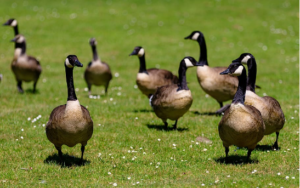 Human settlement has also rapidly changed the once forested Ontario landscape to one of vast expanses of manicured grass, suburban sprawl and fields of corn and grain. With few predators and abundant food supply the exploding populations of Canada goose are overgrazing and despoiling the land and water. They are also taking over habitats once the preserve of native species of birds.
Human settlement has also rapidly changed the once forested Ontario landscape to one of vast expanses of manicured grass, suburban sprawl and fields of corn and grain. With few predators and abundant food supply the exploding populations of Canada goose are overgrazing and despoiling the land and water. They are also taking over habitats once the preserve of native species of birds.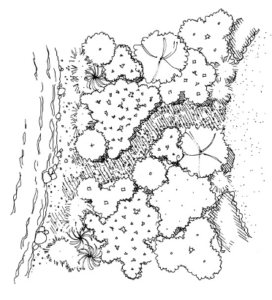
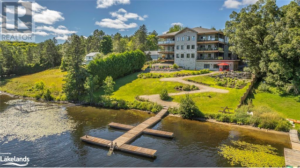
 Master Gardener Carolyn Langdon advises you to build a small rain garden at the top of your slope. Add a small berm at the top of and/or mid-way down your slope. Put in a berm of logs, branches, soil and/or rocks to slow down the water running off and to allow time for the rain to absorb and for plant roots to establish. The idea is to place any material that will act to obstruct or slow down the path of water. Organic material has the additional benefit of providing texture and nutrients to your soil as it breaks down.
Master Gardener Carolyn Langdon advises you to build a small rain garden at the top of your slope. Add a small berm at the top of and/or mid-way down your slope. Put in a berm of logs, branches, soil and/or rocks to slow down the water running off and to allow time for the rain to absorb and for plant roots to establish. The idea is to place any material that will act to obstruct or slow down the path of water. Organic material has the additional benefit of providing texture and nutrients to your soil as it breaks down.